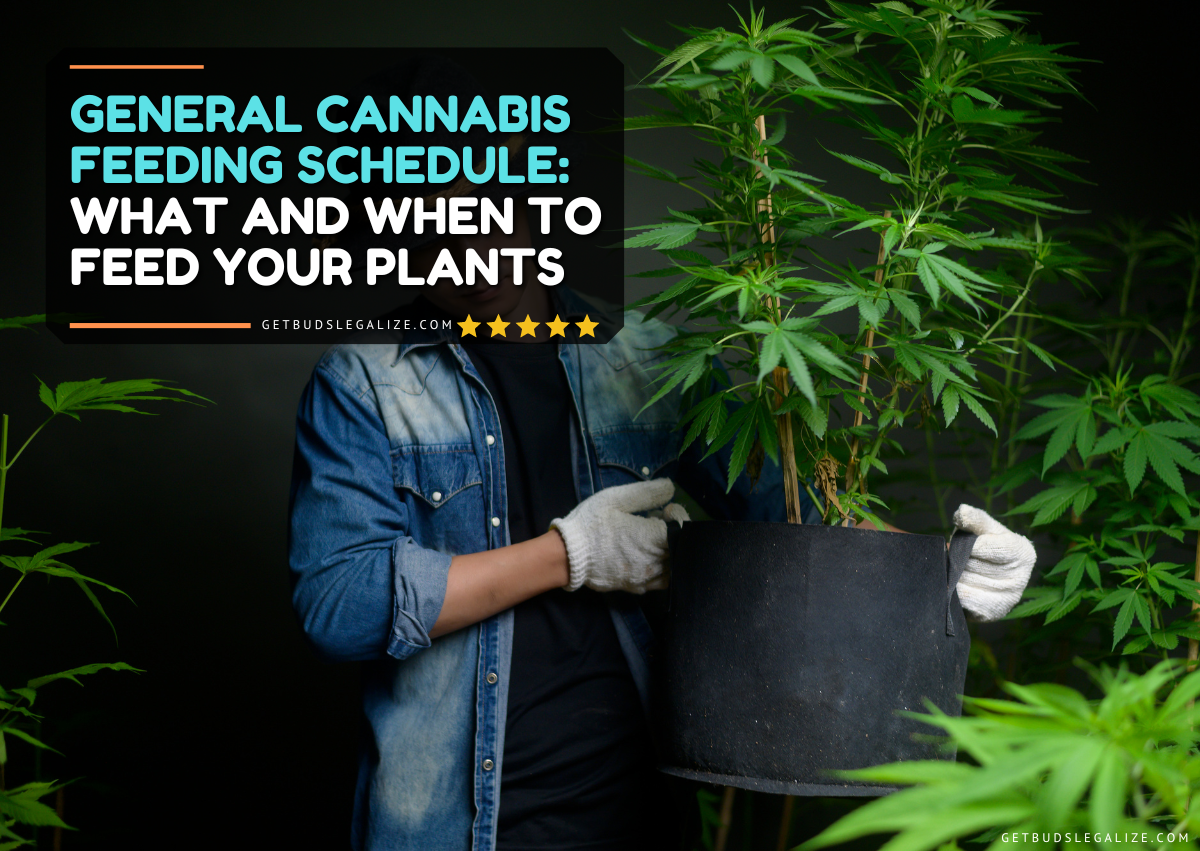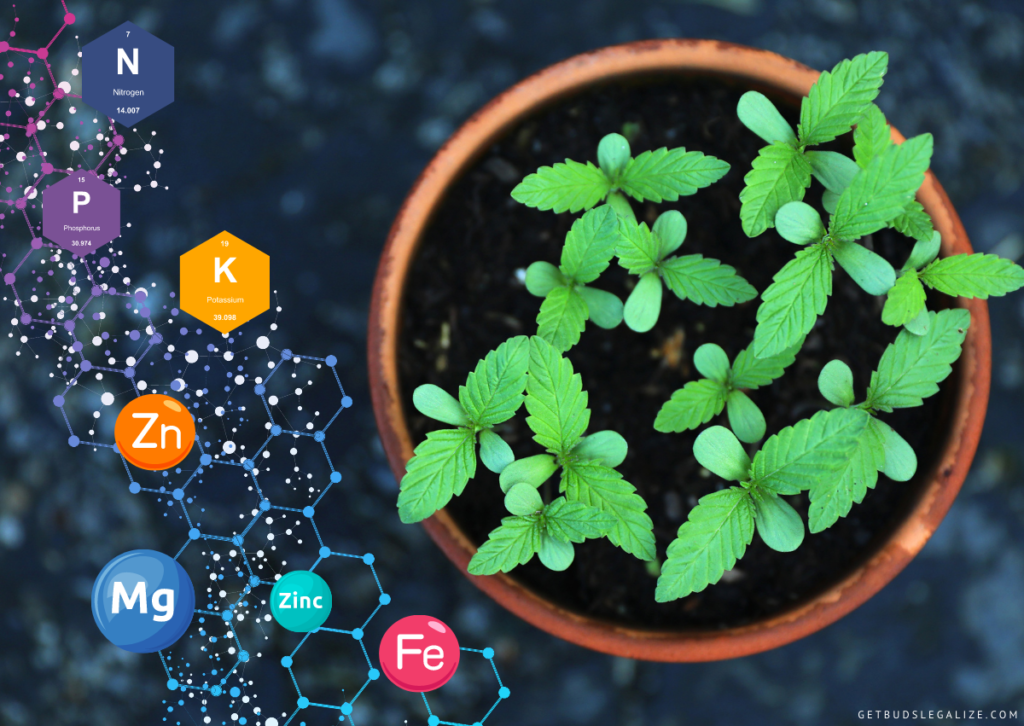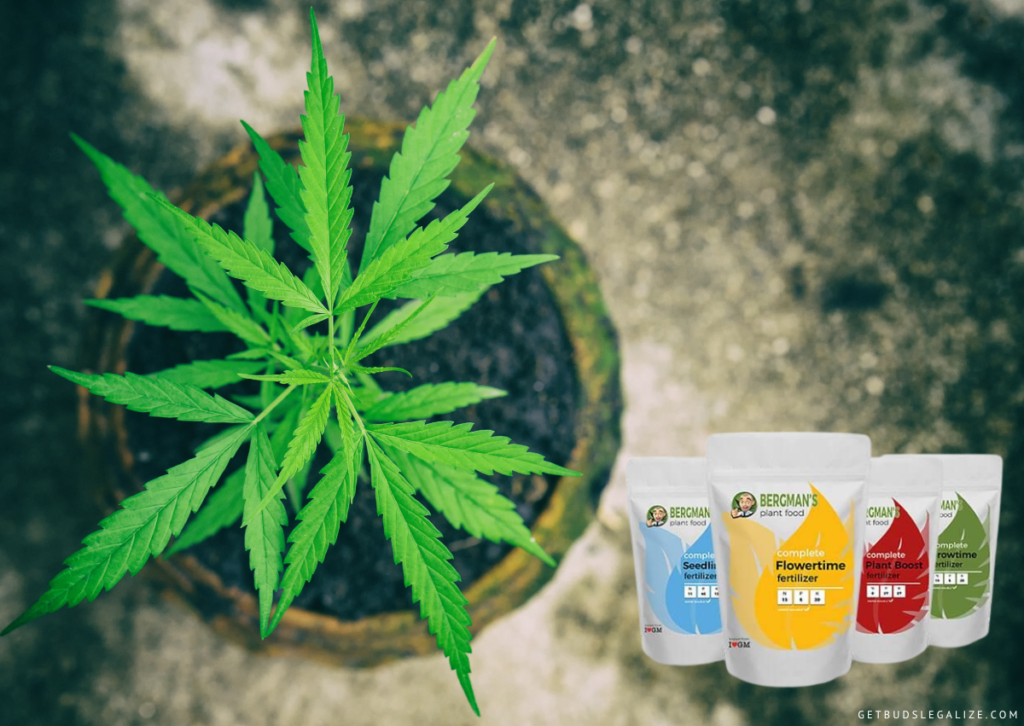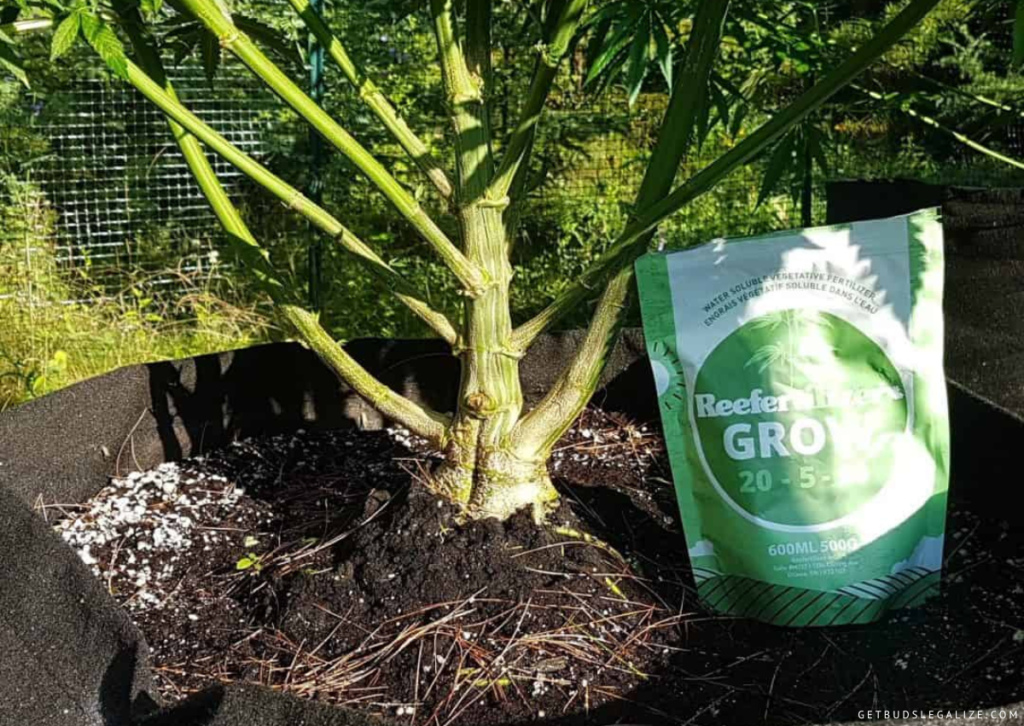General Cannabis Feeding Schedule: What and When to Feed Your Plants



General Cannabis Feeding Schedule: What and When to Feed Your Plants
If you want to grow healthy and potent cannabis plants, you need to provide them with the right nutrients at the right time. Cannabis plants have different nutritional needs depending on their stage of growth, their environment, and their strain.
In this blog post, we will discuss the essential nutrients required by cannabis plants and highlight the distinctions between organic and chemical nutrients. Additionally, we will provide guidance on selecting the optimal nutrient product for your cannabis plants while addressing common issues that may arise during the feeding process and how to address them proactively.
What Are The Main Nutrients That Cannabis Plants Need?
Cannabis plants need three main nutrients: nitrogen (N), phosphorus (P), and potassium (K). These are also known as macronutrients or NPK. These nutrients are essential for the growth, development, and flowering of cannabis plants.
Nitrogen is responsible for the green color of the leaves and stems, and it helps with photosynthesis and protein synthesis. Phosphorus is important for the root development, energy transfer, and flowering of cannabis plants. Potassium is involved in water regulation, enzyme activation, and sugar production.
What Are The Secondary and Micronutrients That Cannabis Plants Need?
Besides NPK, cannabis plants also need some secondary nutrients and micronutrients. These are also called trace elements or microelements. These nutrients are needed in smaller amounts, but they are still important for the health and quality of cannabis plants.
Some of the secondary nutrients are calcium (Ca), magnesium (Mg), and sulfur (S). Calcium is important for cell wall structure and stability, magnesium is essential for chlorophyll production and photosynthesis, and sulfur is involved in amino acid and protein synthesis.
Some of the micronutrients are iron (Fe), zinc (Zn), molybdenum (Mo), copper (Cu), manganese (Mn), boron (B), and chlorine (Cl). Iron is important for chlorophyll formation and oxygen transport. Manganese is involved in enzyme activation and photosynthesis. Zinc is essential for hormone production and growth regulation. Copper is important for enzyme activation and pigment formation. Boron is involved in cell division and sugar transport. Molybdenum is essential for nitrogen fixation and metabolism, and Chlorine is involved in water regulation and photosynthesis.
What Are The Differences Between Organic and Chemical Nutrients?

Organic nutrients are derived from natural sources, such as compost, worm castings, bat guano, fish meal, bone meal, kelp, molasses, etc. They are usually mixed with soil or water and applied to the plants.
Nutrients derived from organic sources are rich in micronutrients and beneficial microorganisms that improve soil quality and plant health. They also enhance the flavor and aroma of your buds, as well as their medicinal properties.
Chemical nutrients are synthetic substances that are formulated to provide the exact amount of macronutrients (nitrogen, phosphorus, potassium) and micronutrients (calcium, magnesium, iron, etc.) that your plants need. They are usually dissolved in water and applied to the plants through a drip system or a spray bottle.
Chemical nutrients are easy to use and measure, and they can boost the growth and yield of your plants. However, they can also cause nutrient burn, salt buildup, pH imbalance, and environmental pollution if not used properly.


How Do I Choose The Right Nutrient Product for My Plants?
There are many cannabis nutrients available on the market, each with its own formula, dosage, and application method. To choose the right one for your plants, you need to consider several factors, such as:
- The type of growing medium you are using (soil, coco coir, hydroponics, etc.)
- The stage of growth your plants are in (vegetative or flowering)
- The strain of cannabis you are growing (indica, sativa, hybrid)
- The quality and quantity of water you have access to
- The pH level of your water and soil
- The climate and temperature of your growing environment
- Your budget and personal preference
As a general rule of thumb, you should look for cannabis nutrients that are specifically designed for cannabis plants, that have a balanced N-P-K ratio (nitrogen-phosphorus-potassium), that contains micronutrients and trace elements, that are compatible with your growing medium and water source, that is easy to use and adjust, and that has positive reviews from other growers.
When Do I Start Feeding My Cannabis Plants?
The answer to this question depends on the type of growing medium you are using. If you are using soil that is already fertilized or enriched with organic matter, you don't need to feed your cannabis plants until they show signs of nutrient deficiency or hunger. This can happen after 3-4 weeks of growth or when the leaves start to turn yellow or pale.
If you are using soil that is poor or depleted in nutrients, you need to start feeding your cannabis plants as soon as they develop their first true leaves (the ones with serrated edges). You should start with a low dose (about 1/4 of the recommended amount) and gradually increase it as your plants grow bigger and stronger.
If you are using coco coir or hydroponics as your growing medium, you need to feed your cannabis plants from day one. Coco coir and hydroponics do not contain any nutrients by themselves, so you need to provide them through a nutrient solution. You should start with a low dose (about 1/4 of the recommended amount) and gradually increase it as your plants grow bigger and stronger.
How Often Do I Feed My Plants?

The frequency of feeding your cannabis plants depends on several factors, such as:
- The type of growing medium you are using.
- The type of nutrient product you are using.
- The stage of growth your plants are in.
- The size and health of your plants.
- The climate and temperature of your growing environment.
To provide guidance, it's recommended to follow these general rules:
- Hydroponics: add nutrients every time you add water to your reservoir or system. You should change the nutrient solution every 1-2 weeks to prevent salt buildup and nutrient lockout.
- Fertilized soil: add nutrients every 1-2 weeks, depending on the strength and quality of your soil. You should flush your soil with plain water every 4-6 weeks to prevent salt buildup and nutrient lockout.
- Poor soil: add a nutrient solution every week, depending on the strength and quality of your soil. You should flush your soil with plain water every 4-6 weeks to prevent salt buildup and nutrient lockout.
How Do I Adjust The Feeding Schedule for Different Stages of Growth?
As you can see from the general cannabis feeding schedule above, you need to adjust the amount and ratio of nutrients you give to your plants depending on their stage of growth. Cannabis plants have different nutritional needs during their vegetative and flowering stages.
During the vegetative stage, cannabis plants need more nitrogen than phosphorus and potassium. Nitrogen is essential for the growth of leaves, stems, and branches. It also helps your plants develop a strong and healthy root system. A good N-P-K ratio for the vegetative stage is 3-1-2 or 4-2-3.
During flowering, cannabis plants need more phosphorus and potassium than nitrogen. Phosphorus is essential for the development of buds, flowers, and resin glands. It also helps your plants resist diseases and pests. Potassium is essential for the transport of sugars, starches, and other nutrients within your plants. It also helps your plants cope with stress and environmental changes. A good N-P-K ratio for the flowering stage is 1-3-2 or 2-4-3.
You can find nutrient products that are specially formulated for each stage of growth, or you can use a balanced N-P-K product and adjust it accordingly.


General Cannabis Feeding Schedule Basics:
To give you a general idea of how to feed your cannabis plants, we have created a simple feed chart that you can follow or modify according to your specific needs and preferences. This schedule is based on a 12-week cycle, from seedling to harvest, using a balanced N-P-K nutrient product. You can adjust the dosage and frequency of feeding depending on the factors we mentioned above.
General Cannabis Feeding Schedule:
Week
Grow stage
Nutrient Requirements
1
Seedling
Use plain water or a very low dose of nutrients (about 1/4 of the recommended amount)
2
Seedling
Use plain water or a very low dose of nutrients (about 1/4 of the recommended amount)
3
Vegetative
Use a low dose of nutrients (about 1/2 of the recommended amount)
4
Vegetative
Use a low dose of nutrients (about 1/2 of the recommended amount)
5
Vegetative
Use a medium dose of nutrients (about 3/4 of the recommended amount)
6
Vegetative
Use a medium dose of nutrients (about 3/4 of the recommended amount)
7
Flowering
Use a high dose of nutrients (about the full recommended amount), with more phosphorus and potassium than nitrogen
8
Flowering
Use a high dose of nutrients (about the full recommended amount), with more phosphorus and potassium than nitrogen
9
Flowering
Use a high dose of nutrients (about the full recommended amount), with more phosphorus and potassium than nitrogen
10
Flowering
Use a high dose of nutrients (about the full recommended amount), with more phosphorus and potassium than nitrogen
11
Flowering
Use a low dose of nutrients (about 1/2 of the recommended amount), with more phosphorus and potassium than nitrogen
12
Flowering
Stop feeding your plants and flush them with plain water for the last week before harvest
How Do I Know If My Plants Need More or Less Nutrients?
The best way to know if your cannabis plants need more or less nutrients is to observe their appearance and behavior. Some signs that your plants need more nutrients include:
- Pale green or yellow leaves
- Purple stems
- Small or thin leaves
- Slow or stunted growth
- Low yield or quality
Some signs that your plants need less nutrients include:
- Dark green or purple leaves
- Burnt or curled leaf tips
- Droopy or clawed leaves
- Reduced growth or yield
Should I Use Supplements and Additives for My Plants?

Supplements and additives are products that can enhance the growth and performance of your cannabis plants but are not essential for their survival. They can provide extra benefits such as boosting the immune system, increasing the yield, improving the flavor, or enhancing the potency of your buds.
However, they can also be expensive, complicated, or unnecessary, depending on your situation and goals. Some common types of supplements and additives for cannabis plants are:
1• Amino Acids:
Amino acids are the building blocks of proteins, which are essential for cannabis metabolism and quality. They are synthesized from nitrogen sources in the soil or air, or recycled from old plant tissues. Amino acids play important roles in enzyme production, photosynthesis, respiration, defense, and signaling. Some examples of amino acids involved in cannabis biochemistry are glutamine, asparagine, arginine, proline, and tryptophan.
How and when to use them:
Amino acids can be applied as foliar sprays or soil drenches during vegetative and flowering. They can help improve nutrient uptake, stress tolerance, resin production, and terpene synthesis. However, they should be used with caution as excess amino acids can cause nutrient imbalances or toxicity.
2• Enzymes:
Enzymes are proteins that facilitate chemical reactions in cannabis plants. They help break down organic matter in the root zone, convert sucrose into glucose for energy, and synthesize cannabinoids from precursor molecules. Enzymes are essential for cannabis growth, development, metabolism, and quality. Some examples of enzymes involved in cannabis biosynthesis are sucrose synthase, chitinase, protease, hydrolase, glucanase, cellulase, and THC synthase.
How and when to use them:
Enzymes can be added to the soil or water to improve the decomposition of organic matter, increase the availability of nutrients, and enhance microbial activity. They can also help prevent salt buildup, root rot, and nutrient lockout. Enzymes can be used throughout the entire growth cycle but are especially beneficial during the transition and flowering.
https://getbudslegalize.com/general-cannabis-feeding-schedule/
Commenti
Posta un commento